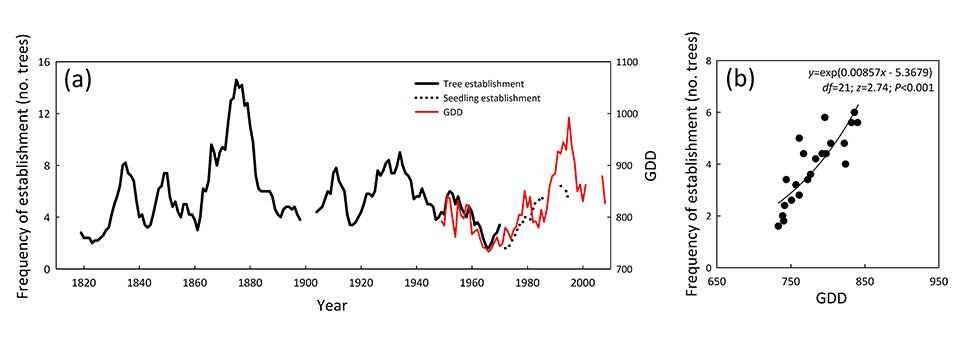Last updated: March 16, 2018
Article
Forest Dynamics in Southwest Alaska
White spruce (Picea glauca) forests are an important landscape component in Lake Clark and Katmai national parks and preserves and are monitored under the vital sign Vegetation Composition and Structure. Warming since the 1980s has led to increased spruce beetle-related mortality in older, denser forest stands, but also to increases in spruce growth and establishment in more open sites, particularly near the forest-tundra margin.
White Spruce Distribution Shaped by Changes in Mortality and Recruitment
Forest monitoring sites arrayed along an east-west gradient (Lake Clark to Katmai) have provided clues to the future distribution of white spruce. Tree-ring data have shown that trees killed by the recent beetle outbreak were often moisture stressed prior to death and those that survived were better able to access snowmelt water (Csank et al. 2016). Outside of those areas of beetle kill, trees at most sites have shown increased growth in response to warming (Sherriff et al. 2017). Warmer periods have also supported periods of higher seedling recruitment in recent decades (Miller et al. 2017; Figure 1).

Methods
Forest monitoring characterizes stand structure and species composition through a suite of tree and understory measurements. Tree cores collected from white spruce have been used to characterize stand age structure, water status, and radial growth. Monitoring began in 2009 and is conducted at five-year intervals at each site.
References
Csank, A. Z., A. E. Miller, R. L. Sherriff, E. E. Berg, and J. M. Welker. 2016. Tree-ring isotopes reveal drought sensitivity in trees killed by spruce beetle outbreaks in southcentral Alaska. Ecological Applications 26:2001-2020.Miller, A. E., T. L. Wilson, R. L. Sherriff, and J. Walton. 2017. Warming drives a front of white spruce establishment near western treeline, Alaska. Global Change Biology 23:5509-5522.
Sherriff, R. L., A. E. Miller, K. Muth, M. Shriver, and R. Batzel. 2017. Spruce growth responses to warming vary by ecoregion and ecosystem type near the forest-tundra boundary in southwest Alaska. Journal of Biogeography 44:1457-1468.
